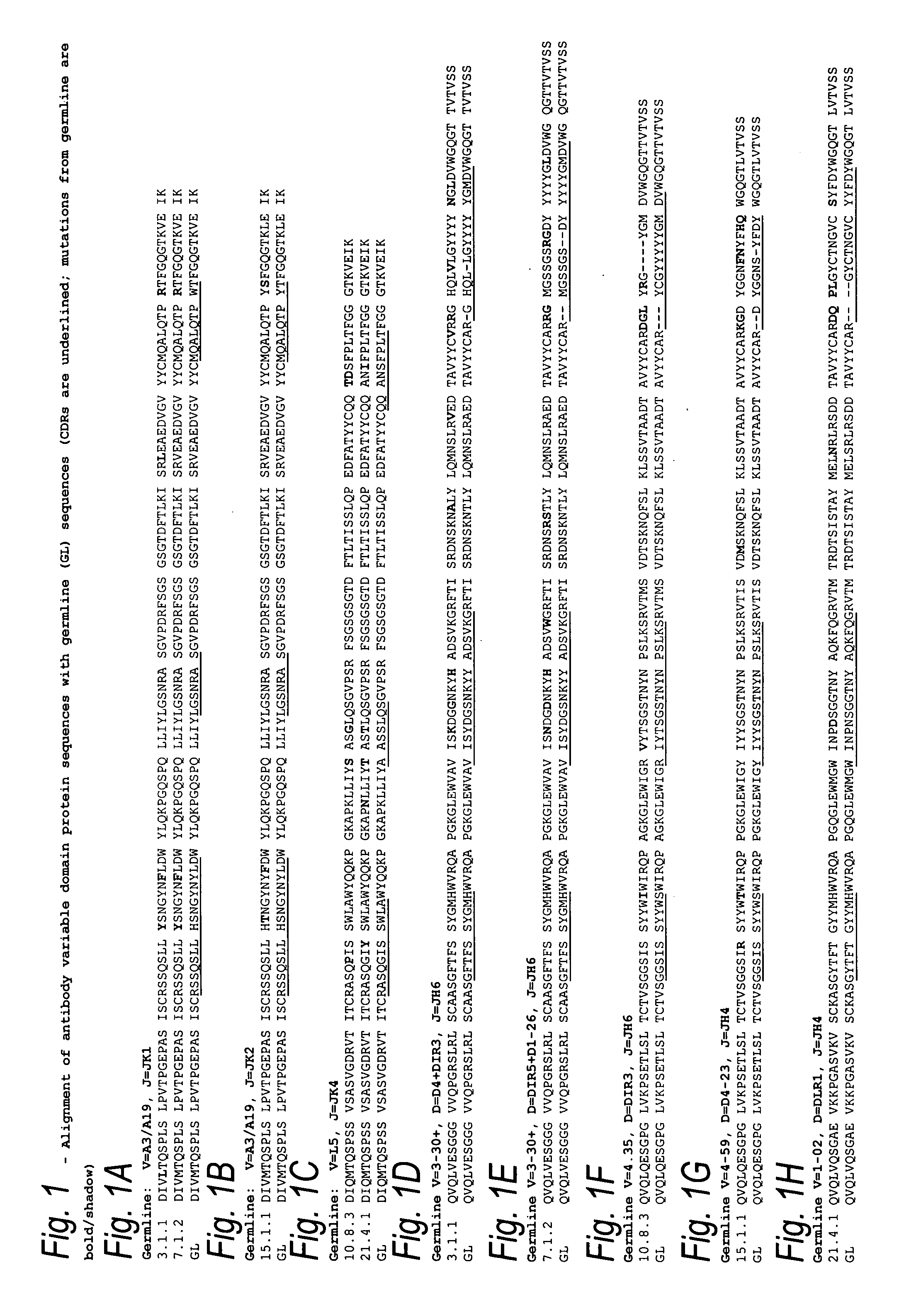Antibodies to CD40
a technology of cd40 and antibodies, applied in the field of antibodies to cd40, can solve the problems of lack of cd4+ t cell priming, abnormal serum immunoglobulin isotype distribution, and defects in secondary humoral responses
- Summary
- Abstract
- Description
- Claims
- Application Information
AI Technical Summary
Benefits of technology
Problems solved by technology
Method used
Image
Examples
example i
Generation of Hybridomas Producing Anti-CD40 Antibody
[0249] Antibodies of the invention were prepared, selected, and assayed as follows:
Immunization and Hybridoma Generation
[0250] We immunized eight to ten week old XenoMice™ intraperitoneally or in their hind footpads with either a CD40-IgG fusion protein (10 μg / dose / mouse) or with 300.19-CD40 cells which is a transfected cell line that express human CD40 on its plasma membrane (10×106 cells / dose / mouse). We repeated this dose five to seven times over a three to eight week period. Four days before fusion, we gave the mice a final injection of the extracellular domain of human CD40 in PBS. We fused the spleen and lymph node lymphocytes from immunized mice with the non-secretory myeloma P3-X63-Ag8.653 cell line, and subjected the fused cells to HAT selection as previously described (Galfre and Milstein, Methods Enzymol. 73:3-46, 1981). We recovered a panel of hybridomas all secreting CD40 specific human IgG2κ antibodies. We selecte...
example ii
Sequences of Anti-CD40-Antibodies Prepared in Accordance with the Invention
[0252] To analyze the structure of antibodies produced in accordance with the invention, we cloned nucleic acids encoding heavy and light chain fragments from hybridomas producing anti-CD40 monoclonal antibodies. Cloning and sequencing was accomplished as follows.
[0253] We isolated Poly(A)+ MRNA from approximately 2×105 hybridoma cells derived from XenoMouse™ mice immunized with human CD40 as described in Example I using a Fast-Track kit (Invitrogen). We followed by PCR the generation of random primed cDNA. We used human VH or human Vκ family specific variable region primers (Marks et al., “Oligonucleotide primers for polymerase chain reaction amplification of human immunoglobulin variable genes and design of family-specific oligonucleotide probes.”Eur. J. Immunol. 21:985-991 (1991)) or a universal human VH primer, MG-30, CAGGTGCAGCTGGAGCAGTCIGG (SEQ ID NO: 118), in conjunction with primers specific for the...
example iii
Analysis of Heavy and Light Chain Amino Acid Substitutions
[0283]FIGS. 1D-1H and 2D-2H provide sequence alignments between the predicted heavy chain variable domain amino acid sequences of monoclonal antibodies 3.1.1, 7.1.2, 10.8.3, 15.1.1, 21.4.1, 21.2.1, 22.1.1, 22.1.1H-C109A, 23.5.1, 23.28.1, 23.28.1H-D16E, 23.29.1 and 24.2.1 antibodies and the germline amino acid sequences of their respective genes. Most of the heavy chain CDR3 regions contain amino acid insertions.
[0284] The DLR1 gene used in the VH domain of antibody 21.4.1 codes for two cysteine (Cys) residues. Mass spectrometry analysis and homology modeling demonstrated that the two Cys residues are disulfide-linked, and that this disulfide link does not disrupt the structure of the antibody.
[0285]FIGS. 1A-1C and 2A-2C provide sequence alignments between the predicted light chain variable amino acid sequences of monoclonal antibodies 3.1.1, 7.1.2, 10.8.3, 15.1.1, 21.4.1, 21.2.1, 22.1.1, 23.5.1, 23.28.1, 23.28.1L-C92A, 23....
PUM
| Property | Measurement | Unit |
|---|---|---|
| W/W | aaaaa | aaaaa |
| W/W | aaaaa | aaaaa |
| W/W | aaaaa | aaaaa |
Abstract
Description
Claims
Application Information
 Login to View More
Login to View More - R&D
- Intellectual Property
- Life Sciences
- Materials
- Tech Scout
- Unparalleled Data Quality
- Higher Quality Content
- 60% Fewer Hallucinations
Browse by: Latest US Patents, China's latest patents, Technical Efficacy Thesaurus, Application Domain, Technology Topic, Popular Technical Reports.
© 2025 PatSnap. All rights reserved.Legal|Privacy policy|Modern Slavery Act Transparency Statement|Sitemap|About US| Contact US: help@patsnap.com



